OPEL MOVANO_B 2019 Owner's Manual
Manufacturer: OPEL, Model Year: 2019, Model line: MOVANO_B, Model: OPEL MOVANO_B 2019Pages: 251, PDF Size: 6.46 MB
Page 151 of 251

Driving and operating149Requests to have the exhaust system
checked and finally the
announcement that an engine restart
will be prevented are displayed in the Driver Information Centre.
Note
These restrictions are a legal
requirement.
At an AdBlue range of 1100 km, a
warning message is displayed in the
Driver Information Centre showing
the remaining distance the vehicle
can travel before engine restarts are
prevented. This warning message is
repeated every 100 km.
Seek the assistance of a workshop as
soon as possible.Warning stages: high emission
warnings 1. ú and A illuminate with warning
message CHECK ANTI-
POLLUTION .
Fault in the system that may result in a loss of engine power.
Seek the assistance of a
workshop as soon as possible.2. ú and A illuminate with warning
message ANTIPOLLUTION xxx
KM FAIL .
Indicates that in less than 1000 km an engine restart will be
prohibited after switching off the
ignition.
This warning message will be
repeated every 100 km. When the range is less than 200 km the
message is repeated every 50
km.
Vehicle speed may be limited to
20 km/h after switching the engine
off and on again until the range is
reduced to 0 km.
Seek the assistance of a
workshop as soon as possible.
3. ú and j illuminate with warning
message ANTIPOLLUTION 0 KM
FAILURE .
The engine cannot be restarted
after switching off the ignition.
Seek the assistance of a
workshop.Illumination of control indicators ú
and j may be accompanied by a
warning chime.
Warning chimes 3 108.
Version without level warnings in the Driver Information Centre
When the AdBlue gauge shows the
level is very low, control indicator ú
first illuminates continuously, then as
AdBlue level drops to a certain
amount ú flashes for a few seconds
then illuminates continuously.
Refill the AdBlue tank as soon as
possible. Refer to "Refilling AdBlue"
below.
Page 152 of 251
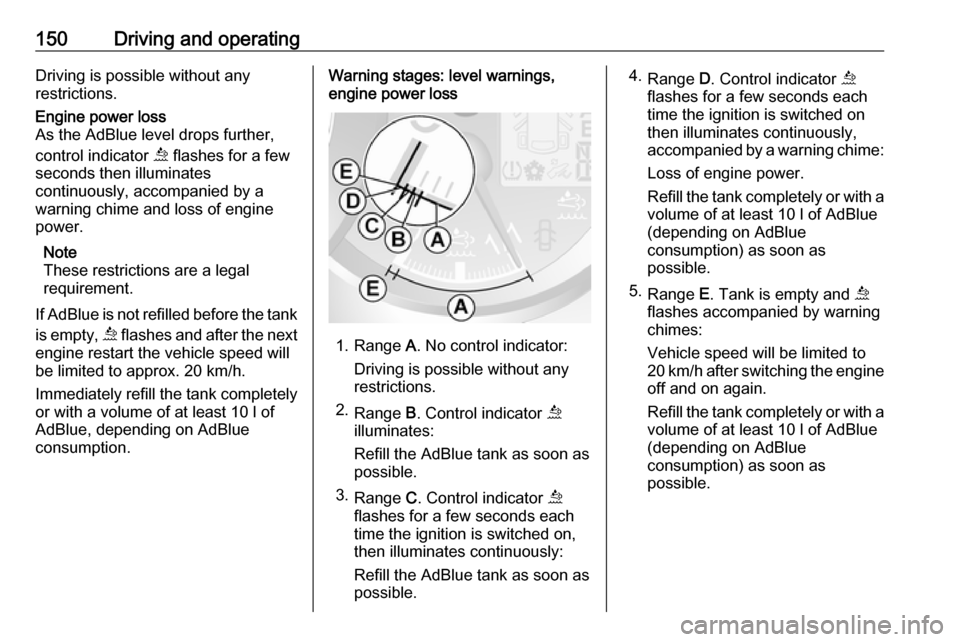
150Driving and operatingDriving is possible without any
restrictions.Engine power loss
As the AdBlue level drops further,
control indicator ú flashes for a few
seconds then illuminates
continuously, accompanied by a
warning chime and loss of engine
power.
Note
These restrictions are a legal
requirement.
If AdBlue is not refilled before the tank
is empty, ú flashes and after the next
engine restart the vehicle speed will
be limited to approx. 20 km/h.
Immediately refill the tank completely or with a volume of at least 10 l of
AdBlue, depending on AdBlue
consumption.Warning stages: level warnings,
engine power loss
1. Range A. No control indicator:
Driving is possible without any
restrictions.
2. Range B. Control indicator ú
illuminates:
Refill the AdBlue tank as soon as
possible.
3. Range C. Control indicator ú
flashes for a few seconds each
time the ignition is switched on,
then illuminates continuously:
Refill the AdBlue tank as soon as
possible.
4. Range D. Control indicator ú
flashes for a few seconds each
time the ignition is switched on
then illuminates continuously,
accompanied by a warning chime:
Loss of engine power.
Refill the tank completely or with a
volume of at least 10 l of AdBlue
(depending on AdBlue
consumption) as soon as
possible.
5. Range E. Tank is empty and ú
flashes accompanied by warning
chimes:
Vehicle speed will be limited to
20 km/h after switching the engine
off and on again.
Refill the tank completely or with a
volume of at least 10 l of AdBlue (depending on AdBlue
consumption) as soon as
possible.
Page 153 of 251
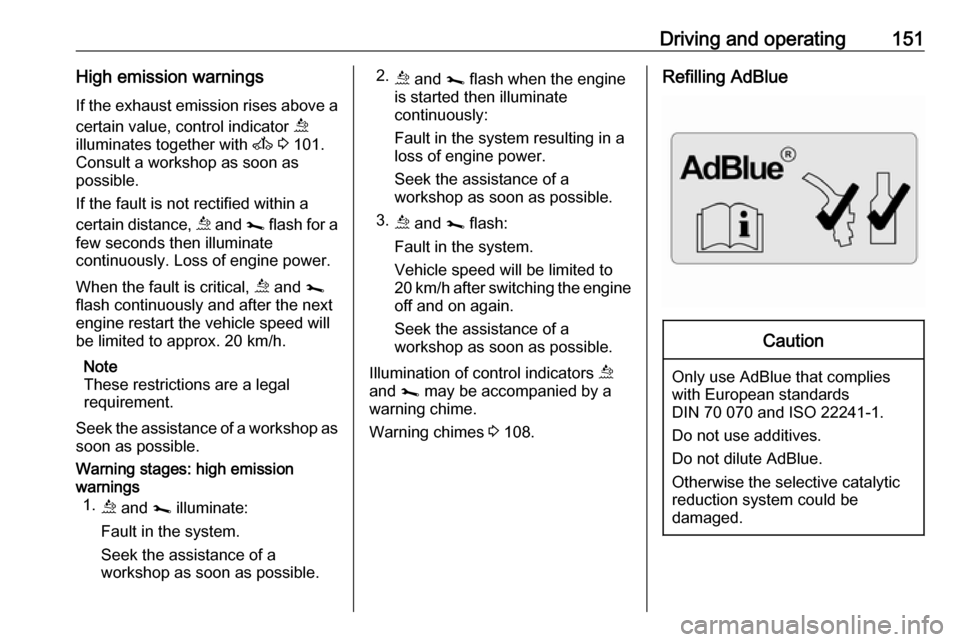
Driving and operating151High emission warningsIf the exhaust emission rises above a
certain value, control indicator ú
illuminates together with A 3 101.
Consult a workshop as soon as
possible.
If the fault is not rectified within a
certain distance, ú and j flash for a
few seconds then illuminate
continuously. Loss of engine power.
When the fault is critical, ú and j
flash continuously and after the next
engine restart the vehicle speed will
be limited to approx. 20 km/h.
Note
These restrictions are a legal
requirement.
Seek the assistance of a workshop as
soon as possible.Warning stages: high emission
warnings 1. ú and j illuminate:
Fault in the system. Seek the assistance of a
workshop as soon as possible.2. ú and j flash when the engine
is started then illuminate continuously:
Fault in the system resulting in a
loss of engine power.
Seek the assistance of a
workshop as soon as possible.
3. ú and j flash:
Fault in the system.
Vehicle speed will be limited to
20 km/h after switching the engine
off and on again.
Seek the assistance of a
workshop as soon as possible.
Illumination of control indicators ú
and j may be accompanied by a
warning chime.
Warning chimes 3 108.Refilling AdBlueCaution
Only use AdBlue that complies
with European standards
DIN 70 070 and ISO 22241-1.
Do not use additives.
Do not dilute AdBlue.
Otherwise the selective catalytic
reduction system could be
damaged.
Page 154 of 251
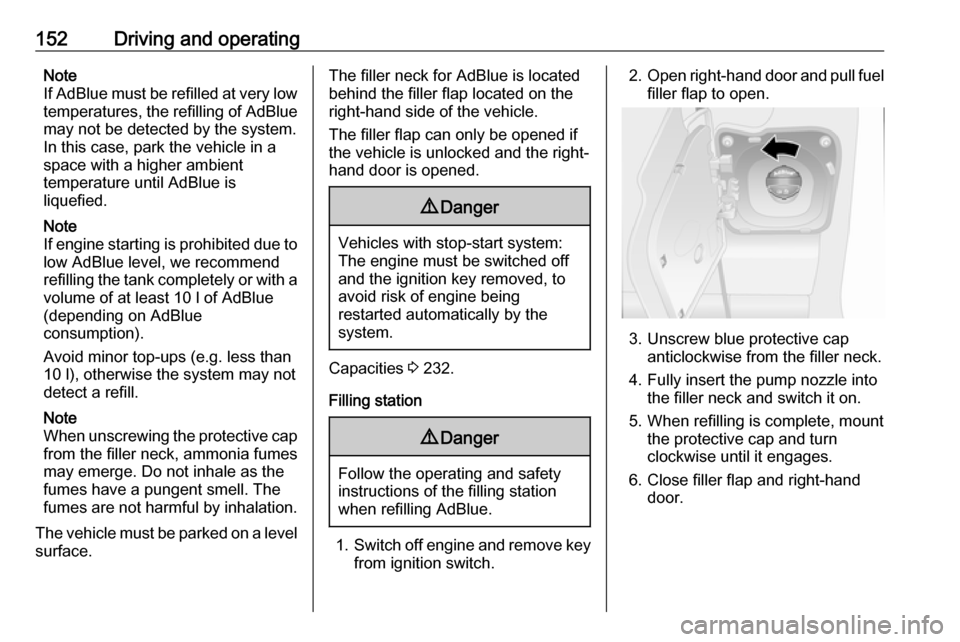
152Driving and operatingNote
If AdBlue must be refilled at very low temperatures, the refilling of AdBlue
may not be detected by the system.
In this case, park the vehicle in a
space with a higher ambient
temperature until AdBlue is
liquefied.
Note
If engine starting is prohibited due to low AdBlue level, we recommend
refilling the tank completely or with a volume of at least 10 l of AdBlue
(depending on AdBlue
consumption).
Avoid minor top-ups (e.g. less than
10 l), otherwise the system may not
detect a refill.
Note
When unscrewing the protective cap from the filler neck, ammonia fumes
may emerge. Do not inhale as the fumes have a pungent smell. The
fumes are not harmful by inhalation.
The vehicle must be parked on a level surface.The filler neck for AdBlue is located
behind the filler flap located on the
right-hand side of the vehicle.
The filler flap can only be opened if
the vehicle is unlocked and the right-
hand door is opened.9 Danger
Vehicles with stop-start system:
The engine must be switched off
and the ignition key removed, to
avoid risk of engine being
restarted automatically by the
system.
Capacities 3 232.
Filling station
9 Danger
Follow the operating and safety
instructions of the filling station
when refilling AdBlue.
1. Switch off engine and remove key
from ignition switch.
2. Open right-hand door and pull fuel
filler flap to open.
3. Unscrew blue protective cap anticlockwise from the filler neck.
4. Fully insert the pump nozzle into the filler neck and switch it on.
5. When refilling is complete, mount the protective cap and turn
clockwise until it engages.
6. Close filler flap and right-hand door.
Page 155 of 251
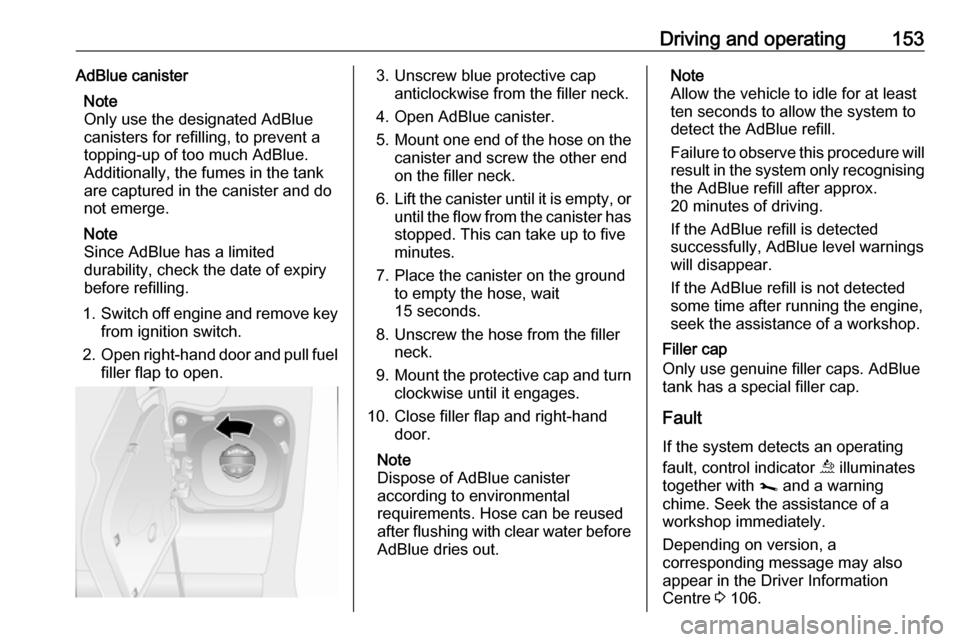
Driving and operating153AdBlue canisterNote
Only use the designated AdBlue
canisters for refilling, to prevent a
topping-up of too much AdBlue.
Additionally, the fumes in the tank
are captured in the canister and do
not emerge.
Note
Since AdBlue has a limited
durability, check the date of expiry
before refilling.
1. Switch off engine and remove key
from ignition switch.
2. Open right-hand door and pull fuel
filler flap to open.3. Unscrew blue protective cap anticlockwise from the filler neck.
4. Open AdBlue canister.
5. Mount one end of the hose on the
canister and screw the other end
on the filler neck.
6. Lift the canister until it is empty, or
until the flow from the canister has stopped. This can take up to five
minutes.
7. Place the canister on the ground to empty the hose, wait
15 seconds.
8. Unscrew the hose from the filler neck.
9. Mount the protective cap and turn
clockwise until it engages.
10. Close filler flap and right-hand door.
Note
Dispose of AdBlue canister
according to environmental
requirements. Hose can be reused
after flushing with clear water before
AdBlue dries out.Note
Allow the vehicle to idle for at least
ten seconds to allow the system to
detect the AdBlue refill.
Failure to observe this procedure will
result in the system only recognising the AdBlue refill after approx.
20 minutes of driving.
If the AdBlue refill is detected
successfully, AdBlue level warnings
will disappear.
If the AdBlue refill is not detected
some time after running the engine,
seek the assistance of a workshop.
Filler cap
Only use genuine filler caps. AdBlue tank has a special filler cap.
Fault
If the system detects an operating
fault, control indicator ú illuminates
together with j and a warning
chime. Seek the assistance of a
workshop immediately.
Depending on version, a
corresponding message may also
appear in the Driver Information
Centre 3 106.
Page 156 of 251
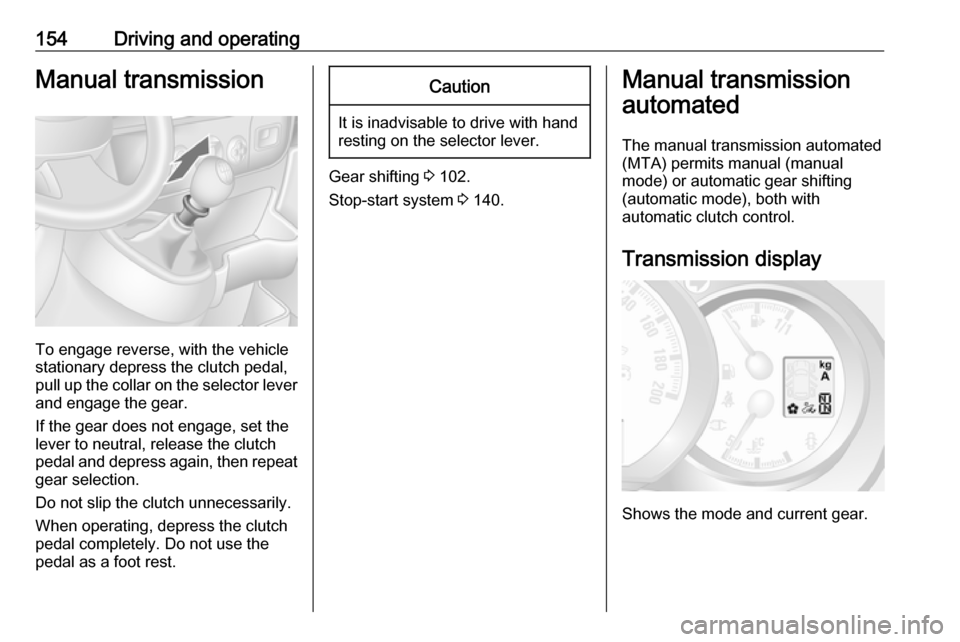
154Driving and operatingManual transmission
To engage reverse, with the vehicle
stationary depress the clutch pedal, pull up the collar on the selector lever
and engage the gear.
If the gear does not engage, set the
lever to neutral, release the clutch
pedal and depress again, then repeat
gear selection.
Do not slip the clutch unnecessarily.
When operating, depress the clutch pedal completely. Do not use the
pedal as a foot rest.
Caution
It is inadvisable to drive with hand
resting on the selector lever.
Gear shifting 3 102.
Stop-start system 3 140.
Manual transmission
automated
The manual transmission automated (MTA) permits manual (manual
mode) or automatic gear shifting
(automatic mode), both with
automatic clutch control.
Transmission display
Shows the mode and current gear.
Page 157 of 251
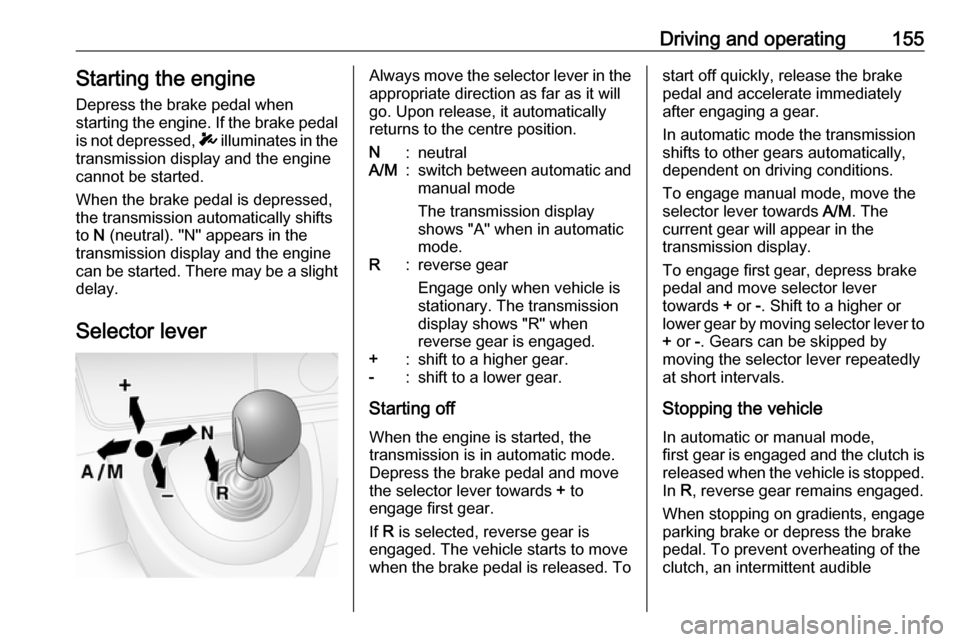
Driving and operating155Starting the engine
Depress the brake pedal when
starting the engine. If the brake pedal
is not depressed, T illuminates in the
transmission display and the engine
cannot be started.
When the brake pedal is depressed,
the transmission automatically shifts
to N (neutral). "N" appears in the
transmission display and the engine
can be started. There may be a slight delay.
Selector leverAlways move the selector lever in the
appropriate direction as far as it will
go. Upon release, it automatically
returns to the centre position.N:neutralA/M:switch between automatic and manual mode
The transmission display
shows "A" when in automatic
mode.R:reverse gear
Engage only when vehicle is
stationary. The transmission
display shows "R" when
reverse gear is engaged.+:shift to a higher gear.-:shift to a lower gear.
Starting off
When the engine is started, the
transmission is in automatic mode. Depress the brake pedal and move
the selector lever towards + to
engage first gear.
If R is selected, reverse gear is
engaged. The vehicle starts to move
when the brake pedal is released. To
start off quickly, release the brake pedal and accelerate immediately
after engaging a gear.
In automatic mode the transmission
shifts to other gears automatically,
dependent on driving conditions.
To engage manual mode, move the
selector lever towards A/M. The
current gear will appear in the
transmission display.
To engage first gear, depress brake
pedal and move selector lever
towards + or -. Shift to a higher or
lower gear by moving selector lever to + or -. Gears can be skipped by
moving the selector lever repeatedly
at short intervals.
Stopping the vehicle In automatic or manual mode,
first gear is engaged and the clutch is
released when the vehicle is stopped.
In R, reverse gear remains engaged.
When stopping on gradients, engage
parking brake or depress the brake
pedal. To prevent overheating of the
clutch, an intermittent audible
Page 158 of 251
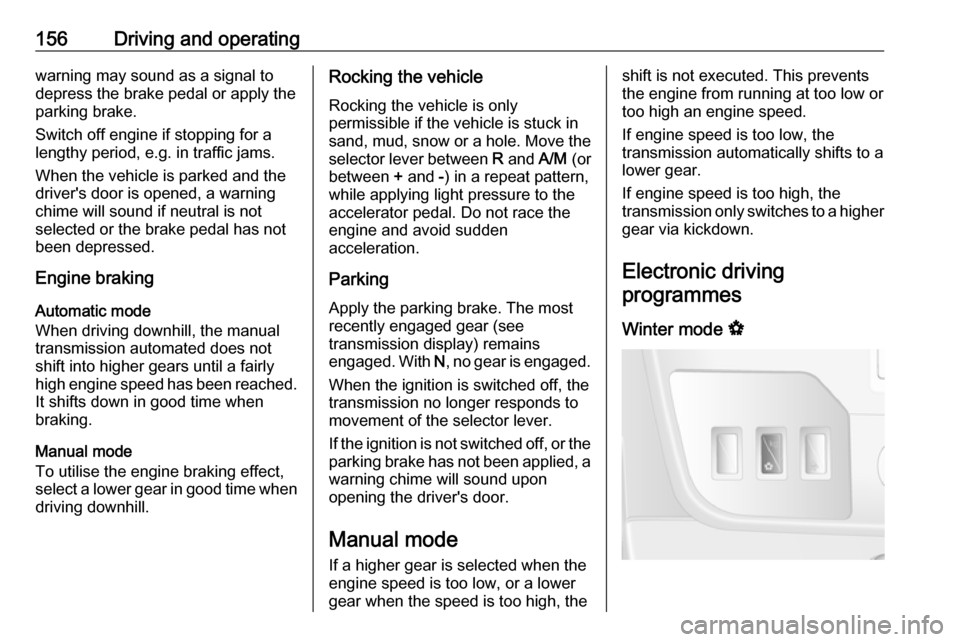
156Driving and operatingwarning may sound as a signal to
depress the brake pedal or apply the
parking brake.
Switch off engine if stopping for a
lengthy period, e.g. in traffic jams.
When the vehicle is parked and the
driver's door is opened, a warning
chime will sound if neutral is not
selected or the brake pedal has not
been depressed.
Engine braking
Automatic mode
When driving downhill, the manual
transmission automated does not
shift into higher gears until a fairly
high engine speed has been reached. It shifts down in good time when
braking.
Manual mode
To utilise the engine braking effect,
select a lower gear in good time when
driving downhill.Rocking the vehicle
Rocking the vehicle is only
permissible if the vehicle is stuck in
sand, mud, snow or a hole. Move the
selector lever between R and A/M (or
between + and -) in a repeat pattern,
while applying light pressure to the
accelerator pedal. Do not race the
engine and avoid sudden
acceleration.
Parking
Apply the parking brake. The most
recently engaged gear (see
transmission display) remains
engaged. With N, no gear is engaged.
When the ignition is switched off, the
transmission no longer responds to
movement of the selector lever.
If the ignition is not switched off, or the
parking brake has not been applied, a
warning chime will sound upon
opening the driver's door.
Manual mode If a higher gear is selected when the
engine speed is too low, or a lower
gear when the speed is too high, theshift is not executed. This prevents
the engine from running at too low or too high an engine speed.
If engine speed is too low, the
transmission automatically shifts to a
lower gear.
If engine speed is too high, the
transmission only switches to a higher gear via kickdown.
Electronic driving programmes
Winter mode V
Page 159 of 251
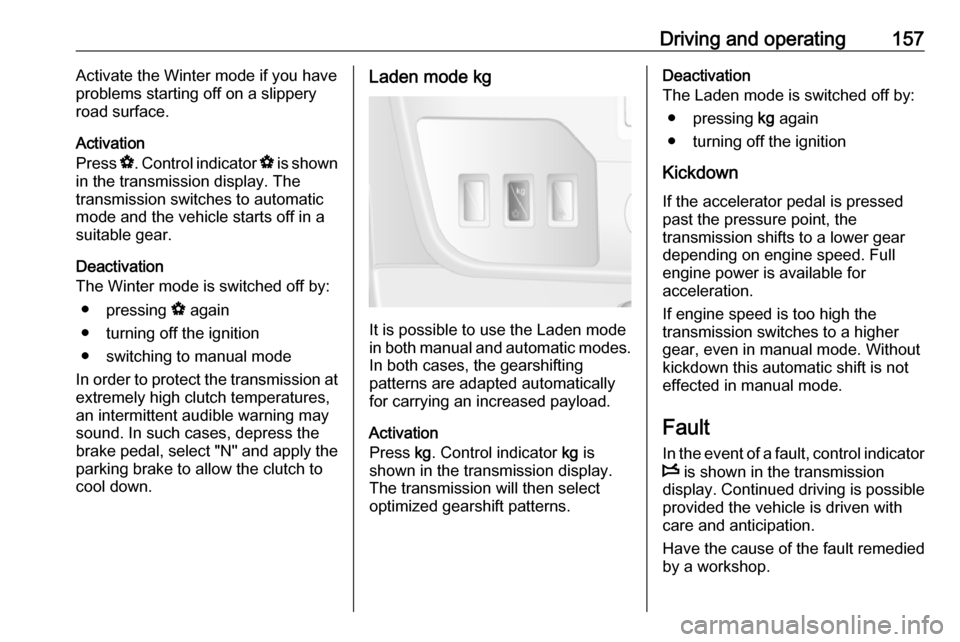
Driving and operating157Activate the Winter mode if you have
problems starting off on a slippery
road surface.
Activation
Press V. Control indicator V is shown
in the transmission display. The
transmission switches to automatic
mode and the vehicle starts off in a
suitable gear.
Deactivation
The Winter mode is switched off by:
● pressing V again
● turning off the ignition
● switching to manual mode
In order to protect the transmission at
extremely high clutch temperatures,
an intermittent audible warning may
sound. In such cases, depress the
brake pedal, select "N" and apply the parking brake to allow the clutch to
cool down.Laden mode kg
It is possible to use the Laden mode
in both manual and automatic modes. In both cases, the gearshifting
patterns are adapted automatically
for carrying an increased payload.
Activation
Press kg. Control indicator kg is
shown in the transmission display.
The transmission will then select
optimized gearshift patterns.
Deactivation
The Laden mode is switched off by:
● pressing kg again
● turning off the ignition
Kickdown If the accelerator pedal is pressed
past the pressure point, the
transmission shifts to a lower gear
depending on engine speed. Full
engine power is available for
acceleration.
If engine speed is too high the
transmission switches to a higher
gear, even in manual mode. Without
kickdown this automatic shift is not
effected in manual mode.
Fault
In the event of a fault, control indicator W is shown in the transmission
display. Continued driving is possible
provided the vehicle is driven with
care and anticipation.
Have the cause of the fault remedied
by a workshop.
Page 160 of 251

158Driving and operatingInterruption of power supplyThe clutch is not disengaged if there
is an interruption of the power supply
when a gear is engaged. The vehicle
cannot move.
If the vehicle battery is discharged,
start the vehicle using jump leads
3 218.
If the cause of the fault is not a
discharged vehicle battery, seek the
assistance of a workshop.
If neutral cannot be selected, the
vehicle must only be towed with the
drive wheels raised off the ground
3 221.
Towing the vehicle 3 221.Brakes
The brake system comprises two
independent brake circuits.
If a brake circuit fails, the vehicle can
still be braked using the other brake
circuit. However, braking effect is
achieved only when you depress the
brake pedal firmly. You need to use
considerably more force for this. The
braking distance is extended. Seek
the assistance of a workshop before
continuing your journey.
When the engine is not running, the
support of the brake servo unit
disappears once the brake pedal has
been depressed once or twice.
Braking effect is not reduced, but
braking requires significantly greater
force. It is especially important to bear this in mind when being towed.
Control indicator R 3 102.
Antilock brake system
Antilock brake system (ABS)
prevents the wheels from locking.ABS starts to regulate brake pressure as soon as a wheel shows a tendency to lock. The vehicle remains
steerable, even during hard braking.
ABS control is made apparent
through a pulse in the brake pedal
and the noise of the regulation
process.
For optimum braking, keep the brake
pedal fully depressed throughout the
braking process, despite the fact that
the pedal is pulsating. Do not reduce
the pressure on the pedal.
Control indicator u 3 102.
Fault
If control indicators u and j
illuminate with the messages CHECK
ABS and CHECK ESP in the Driver
Information Centre, there is a fault in
the ABS. The brake system remains
operational but without ABS
regulation.